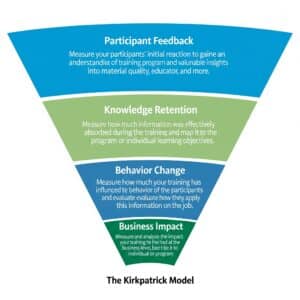The Evolution of Corporate Training Assessment Methods and the Continued Relevance of the Kirkpatrick Model in 2025
Over recent decades, corporate training assessment methods have undergone a remarkable transformation. They have shifted from straightforward tests to sophisticated, data-driven frameworks that provide a comprehensive view of training effectiveness. This evolution reflects a growing understanding that robust assessment is essential for measuring learning impact, optimizing investments, and aligning employee development with organizational objectives.
Initially, traditional assessments concentrated mainly on immediate knowledge recall through quizzes and tests. While easy to administer, these methods often failed to evaluate real-world application or behavioral change—key indicators of successful training. To address these gaps, organizations incorporated performance demonstrations, 360-degree feedback, and on-the-job observations, providing a more accurate picture of how learning translates into workplace performance.
In the early 2000s, the Kirkpatrick Model emerged as a groundbreaking framework for systematic training evaluation. Developed by Donald Kirkpatrick, it introduced four distinct levels: Reaction, Learning, Behavior, and Results. Its straightforward structure and ability to connect learner satisfaction with tangible business outcomes made it a cornerstone for training effectiveness assessments.
Fast forward to 2025, the training assessment landscape is heavily influenced by digital transformation, big data, and analytics. Learning Management Systems (LMS) now allow for real-time data collection, enabling continuous monitoring and refinement of training initiatives. Despite these technological advances, the Kirkpatrick Model remains relevant due to its adaptable structure and proven track record in linking training to strategic results.
In-Depth Comparison of the Four Levels: Reaction, Learning, Behavior, and Results
Understanding how to measure training impact effectively requires a deep grasp of the four foundational levels—Reaction, Learning, Behavior, and Results. Traditionally, evaluations relied on basic methods, but by 2025, new approaches deliver more precise, actionable insights. This section explores each level, contrasting old and new methodologies to prepare organizations for the future of corporate development.
Reaction: Gauging Immediate Engagement and Satisfaction
Historically, Reaction levels used post-training surveys to assess learner satisfaction and perceived usefulness. These subjective evaluations offered limited insight, often serving as immediate indicators rather than long-term metrics.
Nowadays, reaction assessments have advanced significantly. AI-driven sentiment analysis and natural language processing (NLP) enable real-time, holistic evaluations of emotional engagement. Virtual reality (VR) environments and gamified feedback methods also empower learners to express reactions interactively, leading to richer data and better understanding of learner experience.
Learning: Tracking Knowledge Acquisition and Skills
Traditional evaluation relied on pre- and post-tests, which verified knowledge gains but often lacked depth regarding practical application. These methods sometimes failed to gauge true competence or long-term retention.
Modern solutions feature AI-powered adaptive assessments that customize questions based on individual proficiency levels, providing a nuanced view of progress. Micro-credentials and digital badges offer detailed evidence of specific skills acquired, while virtual labs and simulations replicate real-world tasks to ensure knowledge translates into practical ability.
Behavior: Observing Changes in Workplace Application
Behavioral shifts used to be measured via self-assessments and periodic supervisor reviews, often delayed and subjective. These approaches limited the ability to monitor ongoing change.
In 2025, continuous behavioral monitoring employs wearable devices, LMS analytics, and enterprise data. AI analytics identify behavioral patterns aligned with training objectives. Additionally, social collaboration tools gather peer feedback, enabling real-time, data-rich assessments of how learning is applied on the job.
Results: Quantifying Business Impact and ROI
Earlier, results assessments depended on delayed metrics such as sales growth or productivity, which could be influenced by external factors. Their accuracy was often compromised by confounding variables.
Today, predictive analytics and machine learning models link training directly to KPIs in near real-time. Integrated enterprise data allows granular causality analysis, illustrating how specific training initiatives impact revenue, customer satisfaction, or operational efficiency. Interactive dashboards foster ongoing optimization aligned with strategic goals.
Summary: Evolving Perspectives for 2025 and Beyond
The transition from basic to advanced assessment techniques highlights the importance of leveraging emerging technologies. Immersive, data-driven methods increase the accuracy and immediacy of feedback, enabling proactive adjustments. Incorporating tools such as Paradiso LMS facilitates real-time analytics, personalized learning paths, and comprehensive impact analysis, ensuring training initiatives remain aligned with organizational priorities.
Adopting these innovative approaches transforms training evaluation from a static, retrospective process into a continuous strategic activity that fuels organizational growth and agility.
Applying Each Level of the Model: Actionable Guidance for Effective Implementation
Implementing the Kirkpatrick Model successfully requires a strategic approach tailored intricately to each level. By integrating advanced technologies, effective data collection methods, and real-world examples, organizations can optimize their training evaluations for maximum impact. Here are key actionable steps for each level:
Leveraging Technology for Model Implementation
Right technological tools are essential at every stage. Automation platforms streamline data collection, while analytics and AI-driven insights enable dynamic decision-making.
Example: A retail company uses AI-integrated CRM systems to analyze customer interactions, helping tailor training based on actual performance data.
Data Collection Techniques for Accurate Insights
Diverse data sources—surveys, sensors, transactional records—are vital. Ensuring data quality through validation and prompt updates increases reliability across all evaluation levels.
Tip: Use automated tools such as validated online forms and real-time data feeds to gather consistent, accurate information.
Real-World Implementation Examples
- Manufacturing: IoT sensors monitor machinery, enabling predictive maintenance based on data analysis.
- Healthcare: Electronic health records (EHR) support predictive models to reduce patient readmissions, informing training programs.
Strategies for Effective Integration
- Start Small: Pilot programs help test and refine before wider rollout.
- Engage Stakeholders: Collaboration with leadership and teams guarantees buy-in and practical insights.
- Monitor Continuously: Regular evaluation allows timely adjustments.
- Invest in Training: Educate teams on technology use and data interpretation for optimal results.
Combining technological adoption, meticulous data collection, and proven practices creates a strong foundation for impactful training evaluations that foster ongoing growth and innovation.
Challenges and Emerging Opportunities in Corporate Training
Common Challenges in Corporate Training
Implementing effective training often involves overcoming notable hurdles. A major issue is the challenge of measurement—assessing how training impacts actual employee performance and organizational metrics remains complex. Traditional methods like post-training surveys and tests sometimes fall short in capturing long-term retention or application.
According to the Association for Talent Development (ATD), only about 34% of organizations effectively measure training outcomes, highlighting the need for more advanced evaluation tools.
Technological barriers also pose significant challenges. Disparities in device access, internet reliability, and digital literacy can limit participation, especially among remote or smaller organizations.
Resistance to change further complicates digital transformation efforts. Employees hesitant to adopt new tools or methods slow down progress and impact overall success.
Emerging Opportunities: AI-Driven Analytics and Personalized Learning
Despite these challenges, technological advancements open new possibilities to improve training effectiveness. AI-driven analytics provide detailed insights into learner engagement, skill development, and behavior patterns, enabling precise, personalized interventions.
Personalized learning, powered by adaptive technologies, tailors content to individual learners’ needs, preferences, and pace. This approach significantly boosts engagement and knowledge retention—up to 30% increase according to EdTech Review.
By embracing these trends, organizations can turn obstacles into opportunities, creating more impactful, measurable, and learner-centric training programs that align with strategic goals.
How Paradiso LMS Supports Comprehensive Assessment and Reporting Aligned with Kirkpatrick’s Four Levels
Understanding Kirkpatrick’s Four Levels of Evaluation
Developed by Donald Kirkpatrick, this model remains a foundational assessment framework, linking training activities with organizational outcomes:
- Level 1: Reaction — Measures participant engagement and satisfaction.
- Level 2: Learning — Assesses knowledge or skill acquisition.
- Level 3: Behavior — Evaluates the transfer of skills to the workplace.
- Level 4: Results — Connects training to bottom-line organizational results like revenue or customer satisfaction.
An effective LMS should facilitate assessment and reporting for each level, enabling continuous improvement and demonstrated ROI.

Paradiso LMS’s Support for Level 1: Reaction
The platform offers integrated surveys and quizzes immediately after training modules, capturing learner satisfaction in real-time. Customizable forms enable tailored questions aligned with organizational goals, enriching feedback quality.
Support for Level 2: Learning
Assessment tools include quizzes, tests, and practical assignments, with instant auto-grading and comprehensive analytics. Various question types ensure thorough knowledge evaluation, with progress tracked via dashboards and reports.
Facilitating Level 3: Behavior Change
Features like skill tracking, manager assessments, and LMS performance data help monitor behavioral shifts over time. Integrations with performance management systems support external validation of applied skills, while mobile access ensures learning continuity outside formal settings.
Supporting Level 4: Results
Advanced reporting capabilities link training data with KPIs such as sales or operational metrics. Custom reports illustrate the training’s impact on business performance, demonstrating clear ROI.
Paradiso LMS provides customizable dashboards, visualizing data through charts, heatmaps, and graphs for strategic decision-making. This comprehensive data analysis supports targeted improvements and aligns training initiatives with organizational goals.
🚀 Ready to See Paradiso LMS in Action?
Let’s show you how Paradiso LMS can work for you.
Enhancing Training Evaluation in a Digital Era
Leveraging integrated assessment and reporting tools like Paradiso LMS ensures organizations can evaluate training holistically—driving continuous enhancement and delivering measurable value. Supporting all Kirkpatrick levels, the platform empowers data-driven decisions that foster growth and competitive edge.
Choosing such comprehensive solutions is key to maximizing training ROI and embedding learning into strategic organizational processes.
Conclusion
In today’s competitive environment, delivering impactful training that translates into measurable business results is vital. By combining the proven Kirkpatrick Model with advanced LMS solutions like Paradiso LMS, organizations gain a comprehensive, data-driven framework for evaluating training effectiveness across all levels—from learner satisfaction to bottom-line impact.
This integrated approach enhances the ability to make informed decisions, optimize training investments, and foster continuous improvement. Ultimately, adopting such combined methodologies ensures organizations remain agile, competitive, and equipped for sustained growth and success.

















